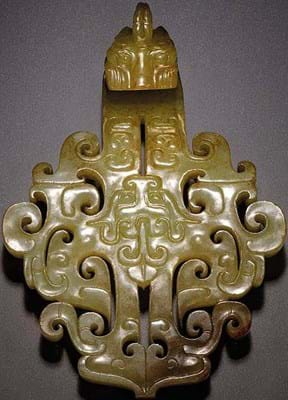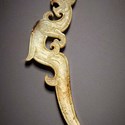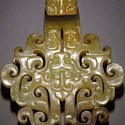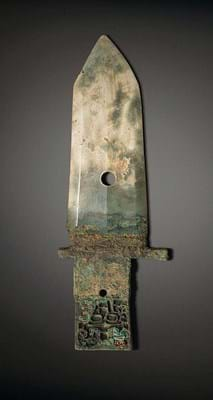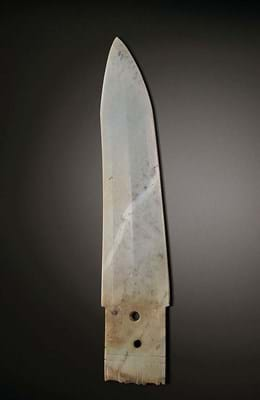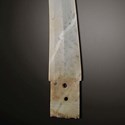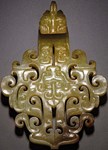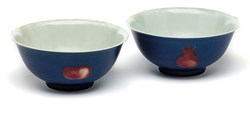Their passion for archaic jades in particular was rewarded with some strong prices – including a record £700,000 for a masterly belt hook (dai got) made during the Western Han period.
‘World’s greatest collector’
The buyer of this and many other lots in the sale had been ‘a princely collector’ from outside the EU, understood to be Sheikh Saud bin Mohammed al-Thani (1966-2014), the Qatari royal who ranked at the time as the world’s most prolific art buyer. Some of his purchases, particularly those from outside the canon of Islamic art, are coming back to the market.
These jades returned to the same saleroom a dozen years later almost to the day.
This time on November 3 the numbers were bigger – and some of them much bigger.
The most spectacular returns came for two finely worked greyish-green jade halberd blades (ge) from the Shang Dynasty, c.1200BC. Twelve years ago, these had made £13,500 (for an 11½in/29cm long blade with a finely worked handle) and £15,500 (for a smaller 9in/23cm long blade retaining elements of a turquoise inlaid bronze shaft). This time they raced away to sell at £230,000 and £170,000 respectively.
A 4½in (11cm) long white and russet jade ‘dragon’ pendant (xi), probably made in Jincun, near present-day Luoyang in Henan, during the Warring States period (475-221BC) had sold in 2008 for £80,000. It took £170,000 on this occasion.
The shape and polish of this ornament is closely related to the example now in the Palace Museum, Beijing, which was excavated from the 4th-3rd century BC tombs at Jincun, thought to have been the resting place of the Zhou royal family.
A smaller 2¾in (7cm) high dragon and phoenix-shaped ornament from the Warring States period, sold as part of a private collection of archaic jades at Christie’s Hong Kong in 2017 for HK$600,000 (£60,000) also bears comparison.
The jewel in the collection was the Western Han belt hook. Shaped from a single slab of translucent, pale yellowish stone with a crested animal-mask, a long-tailed bird and abstract curling patterns, it has survived in virtually perfect condition for more than 2000 years.
Only one comparable is known: that from the 3rd century BCE tomb of a nobleman excavated in 1978 in Shandong Qufu, ancient capital of the Lu State. The estimate was £600,000-800,000. In fact, it sold at £2.45m, the top price of this year’s Asian series.
The £5m ‘property from a princely collection’ also boasted the pair of lavishly decorated Eastern Zhou chariot fittings. They were deemed the ‘Outstanding East Asian Work of Art from an Auction House’ in this year’s Asian Art in London awards. The 10in (26cm) gold and silver inlaid bronze fittings skilfully cast in the zoomorphic form of a three-clawed dragon pursuing a phoenix date from the c.3rd or 4th century BC. It was from this time to the end of the dynastic period that the dragon (emperor) and phoenix (empress) were symbols of imperial power.
They have a provenance back to CT Loo, Paris, in 1930 and were subsequently owned by collectors including the Marquis de Ganay (Paris), Stephen Junkunc III (Chicago) and latterly the dealer Eskenazi.
They carried a guide of £600,000-1m and got away at £1.3m.
The Christie’s buyer’s premium charged was 24/20/14.5%.



